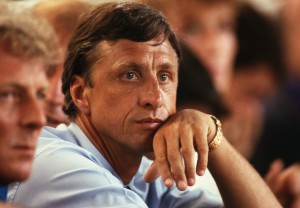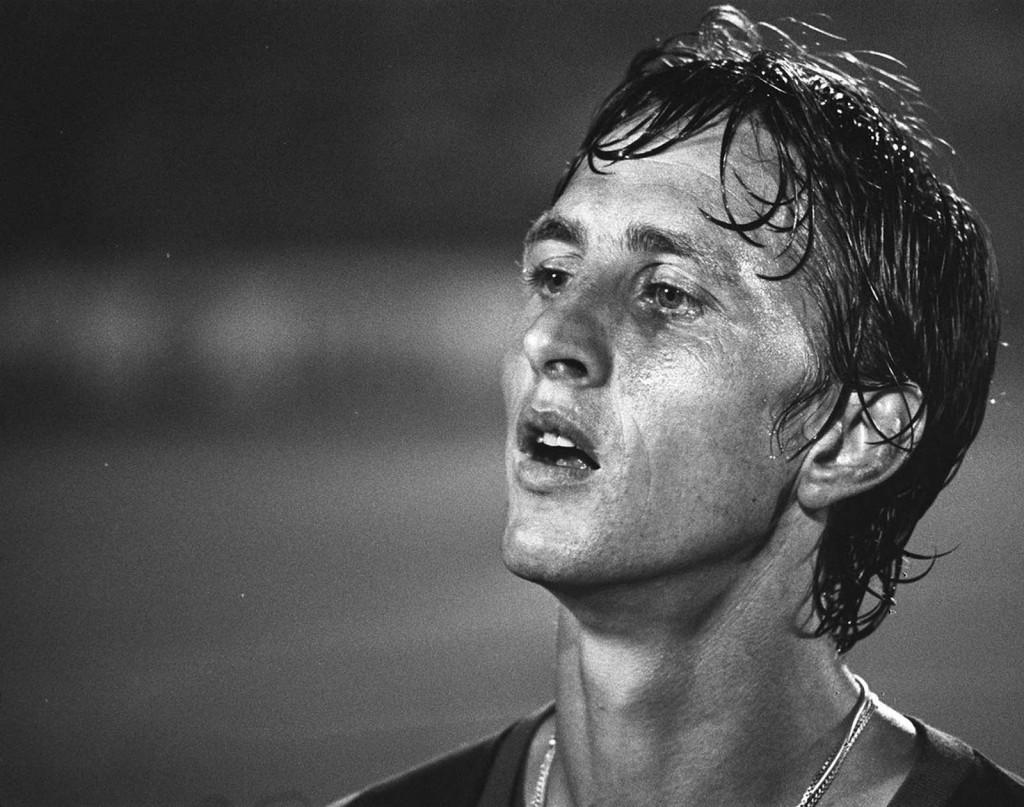If a single moment could be said to have changed the way a generation looked at football, it was the turn with which Johan Cruyff bamboozled the Swedish defender Jan Olsson in the 23rd minute of a group match during the 1974 World Cup finals.
The crowd at the Westfalenstadion in Dortmund rubbed their eyes, unable to believe what they had seen. But it was true.
The Dutch No14 had used his right instep to turn the ball back inside his standing leg before spinning through 180 degrees and sprinting away towards the byline.
He had left the tight-marking Swedish defender looking like a man tricked out of a fiver in a find-the-lady game. When he did the same thing in a 2-0 win against England three years later, there was still enough surprise in the trick to make Wembley swoon. The crowd had been waiting for it, and he did not want to disappoint them.
This was football from another planet, football as reimagined by a master choreographer assigned to strip it down, discard the rusted and outmoded components and reconstruct it in a way that was not just more aesthetically pleasing but more lethally and unanswerably efficient. The result was an approach that seemed to draw not just on a completely new set of skills but on a different mentality, one finally set free from the game as it had been known in its previous incarnations.
Cruyff incarnated the new way. Lithe, slender and as swift as the wind, ferociously competitive, with the strength in his thighs and the anticipation to ride the scything tackles of the time, alert to everything around him and delving into a bottomless bag of technical and tactical tricks, he treated football as, above all, an excuse for exercising creativity. Being Dutch, he was used to questioning the received wisdom, and when he appeared on the international scene towards the end of the 1960s, the game was ready to be shaken up by a bunch of long-haired revolutionaries.
And football has never had a revolutionary quite like Johan Cruyff. This was a man not only capable of holding his place on the all-time list of great individual players – the one including Ferenc Puskas, Alfredo Di Stéfano, Pelé, Diego Maradona, Zinedine Zidane, Cristiano Ronaldo and Lionel Messi – but capable of exerting a wider influence as a thinker, changing the way the world saw football and the way they played it.
He was not alone in this task. In the beginning he needed Rinus Michels, the coach of Ajax, who used the club’s long history of tactical innovation as the basis for the ultimate version of the system that became known as Total Football, and Stefan Kovacs, who succeeded Michels. He needed team-mates such as Piet Keizer, Arie Haan, Johan Neeskens and Ruud Krol, a generation of Dutchmen able to deploy not just great technical skills but imaginations flexible enough to cope with a new way of playing and to flourish within it.
Total Football, it was said, meant that every player could pop up anywhere on the pitch. This was not quite the truth of the matter, but the notion had its origin in the way Ajax’s coaches would make their juniors play out of position – a striker as a full-back, for instance – to give them a deeper insight into the game. Thus empowered to fill in for each other, the Dutch players were certainly harder for their opponents to pin down and nullify.
Cruyff was their leader, whether in the white and red of Ajax or the orange of Holland. When he picked up the ball and paused briefly to lull an opponent before launching an instant sprint, he changed the dynamic of the whole game in a split-second. Messi, his heir as Barcelona’s creative focus, has the same quality today. But no one except, perhaps, Maradona had Cruyff’s range of skills and his ability to redirect the course of a contest. Defenders turned grey chasing vainly after him.
Those deep-set eyes were unusually close together, as if built to focus on the ball at his feet, and his early idol was Faas Wilkes, the Dutch forward renowned for his dribbling skills, whose career began in Rotterdam after the war before taking him to Italy and Spain in the 1950s. But Cruyff’s vision extended to all areas of the pitch.
As a player, there were three European Cups in a row with Ajax, to go with eight Eredivisie titles and five KNVB Cup wins. In Spain there would be one league title and a Copa del Rey win, followed by a league and cup double with Feyenoord immediately before his retirement in 1984.
Only once during that time did he forget that, for all this artistry, the first priority was to beat the opposition.
Unfortunately that was at the highest level of the game, in the 1974 World Cup final. Having made it clear in beating Argentina and Brazil to reach the last stage of the tournament that, under Michels’ guidance, they were at the very height of their powers, Cruyff and his team-mates took the field against West Germany in Munich secure in their own superiority.
It was an assumption seemingly confirmed when they took the lead in the third minute, having kept possession from the kick-off until Cruyff was brought down by Uli Hoeness for a penalty converted by Neeskens. For admirers of the Dutch philosophy, it was a sadness that their complacency allowed a resolute German side to recover and secure the trophy.
In terms of disappointment, that day might have been matched in Cruyff’s career only by his experience as the head coach of Barcelona in May 1994, when his “dream team” – including Romario, Hristo Stoichkov, Pep Guardiola and Ronald Koeman – were trounced 4-0 by Fabio Capello’s Milan on a night that silenced the boisterous Catalan supporters in Athens’ Olympic stadium.
 By that time, however, he had already begun making his second great contribution to football, in laying the foundations for the Barcelona that we enjoy today. He had begun his coaching career well enough back at Ajax, winning the cup twice and giving a debut to the teenaged Dennis Bergkamp, but on his return to the Camp Nou he assembled a team that took the Spanish title four years in a row and captured the 1989 European Cup Winners’ Cup and the 1992 European Cup, both times against Sampdoria. Perhaps even more significantly, he created the academy at La Masia that would produce the likes of Messi, Xavi Hernández and Andrés Iniesta.
By that time, however, he had already begun making his second great contribution to football, in laying the foundations for the Barcelona that we enjoy today. He had begun his coaching career well enough back at Ajax, winning the cup twice and giving a debut to the teenaged Dennis Bergkamp, but on his return to the Camp Nou he assembled a team that took the Spanish title four years in a row and captured the 1989 European Cup Winners’ Cup and the 1992 European Cup, both times against Sampdoria. Perhaps even more significantly, he created the academy at La Masia that would produce the likes of Messi, Xavi Hernández and Andrés Iniesta.
He was sacked in 1996 but continued as a presiding spirit of the club, hovering above a succession of head coaches who retuned and refined the Dutch way that he had instilled, culminating in the intricate style of play developed over the past 10 years by Frank Rijkaard, Guardiola and Luis Enrique.
In the later years, Cruyff’s relationships with his clubs were often turbulent. Appointed technical director of Ajax in 2008, he departed within a month after disagreements. Named honorary president of Barcelona in March 2010, he was removed from the post four months later. A return to Ajax in 2011 in the role of adviser and with a seat on the board lasted a stormy 14 months. When Bert van Marwijk’s uncompromisingly physical Holland side reached the final of the 2010 World Cup, he supported their Spanish opponents.
But that was part of the man, and anyway none of it matters alongside the memories and the surviving images of that glorious athleticism and courageous imagination. With Johan Cruyff, the grace of Rudolf Nureyev came to the football pitch. And football was never the same again.
Source: The Guardian

